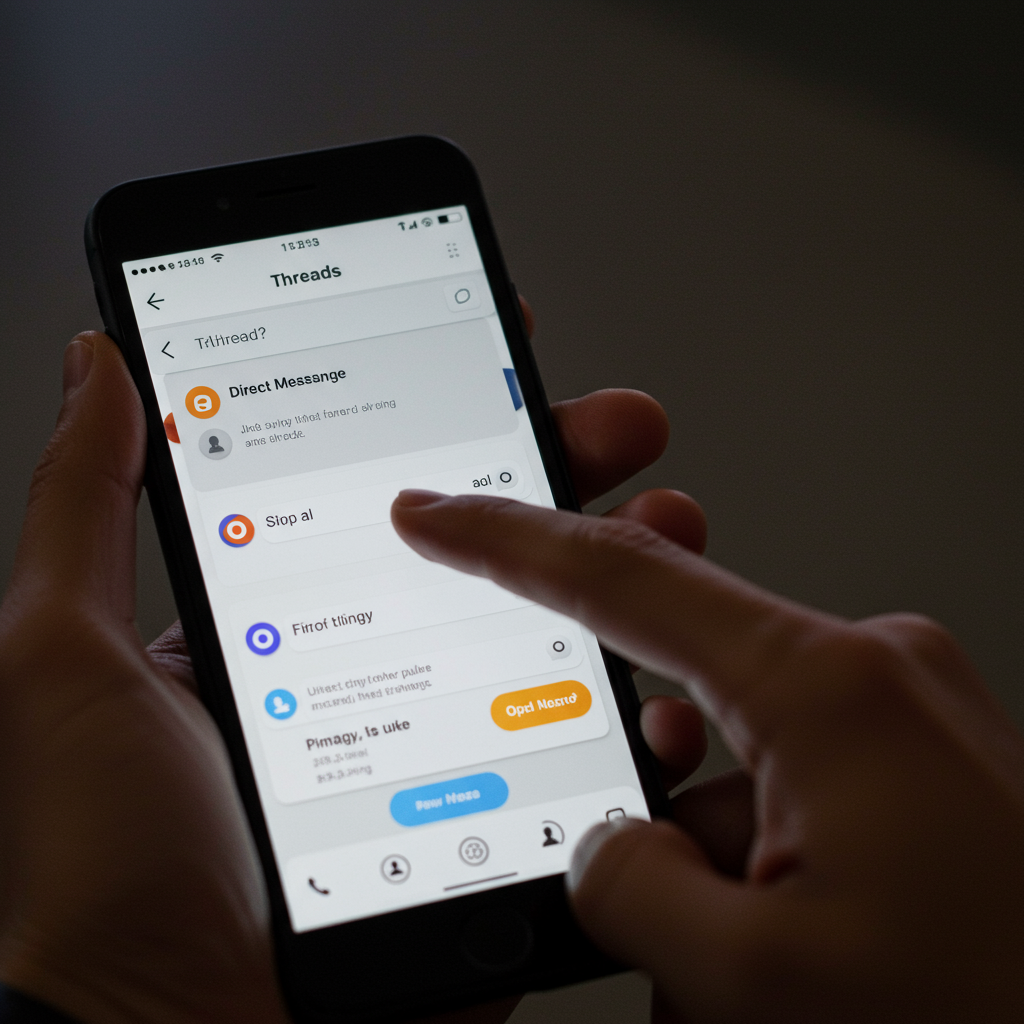Meta’s social network, threads, recently introduced a highly anticipated direct messaging (DM) feature, aiming to enhance in-app interaction and further distinguish itself from Instagram. While private messaging is a standard component on platforms like X (formerly Twitter) and Bluesky, Threads users have met this rollout with significant backlash, particularly over safety and control concerns. The core frustration? There is currently no built-in way for users to completely opt out of receiving DMs.
This lack of control stands in stark contrast to the “highly requested” label Meta initially applied to the feature. Many users, especially women, are vocalizing fears that the addition will unfortunately facilitate harassment, spam, and other unwelcome contact. This reaction challenges the platform’s evolving identity and user expectations, highlighting a disconnect between adding standard features and maintaining a perceived safer online environment.
The Threads DM Rollout: A Feature Arrives
Threads began testing its dedicated in-app direct message inbox in select regions like Hong Kong, Thailand, and Argentina before initiating a global rollout. This move finally provided users with a way to message each other directly within the Threads app, eliminating the previous necessity of switching over to Instagram for one-on-one conversations. The new inbox appears as a separate icon, signaling Threads’ strategic effort to cultivate its own distinct ecosystem, separate from its parent platform.
Initially, the feature supports basic one-on-one text chats, simple emoji reactions, and fundamental reporting and muting capabilities. More advanced functionalities, such as group messaging, inbox filters, and granular message controls, are slated for future updates. The introduction of DMs positions Threads more directly as a competitor to text-first platforms where private communication is already established.
Distancing From Instagram’s Shadow
A key driver behind integrating DMs directly into Threads is the observation that users are building different kinds of networks and engaging with distinct interests on Threads compared to their Instagram profiles. Data from Meta suggests a significant portion of daily Threads users have less than a 50% overlap in their connections between the two apps. Users are reportedly following different accounts and engaging in varied discussions, viewing Instagram more as a space for “creativity” and Threads for sharing “perspectives.” This divergence made relying on the linked Instagram inbox increasingly inconvenient for many Threads users, prompting the demand for a native solution. Meta is even exploring ways for users to access Threads independently, potentially through Facebook logins or Threads-only accounts, further cementing this separation.
Why the Backlash is Brewing
Despite being categorized as a top-requested feature, the implementation of DMs has ignited strong negative reactions from a segment of the user base. The most prominent concern revolves around online safety and the potential for increased harassment. For some users, especially women, the absence of DMs was seen as a deliberate design choice that fostered a different kind of online community – one focused on public discourse rather than private interactions. They felt this public nature made it easier to identify, report, or simply ignore unwanted contact, viewing the platform as a comparatively safer space free from the direct, often hidden, abuse common in private messages on other sites.
User comments reflect this anxiety, with many expressing sentiments ranging from wishing to turn off DMs entirely to lamenting the potential for more online harassment. Some users have sarcastically suggested the feature caters primarily to negative actors rather than enhancing positive interactions. The backlash is visible in responses to official announcements, with many users questioning who truly requested the feature or if any thought was given to negative consequences. One user referenced a poll where a significant number of Threads users reportedly preferred not to have DMs at all, further emphasizing the divide between Meta’s “most-requested” claim and a vocal part of the community’s desires.
The Missing Opt-Out Option
Perhaps the most significant point of contention is the current inability for users to simply disable DMs altogether. While Meta has implemented basic controls, they fall short of providing comprehensive user agency. The system currently requires users to follow each other to initiate a private chat. If a user receives unwelcome messages, their primary options are to unfollow the person (which revokes their ability to DM) or block them entirely (which applies across both Threads and Instagram).
However, critics argue that these controls are insufficient. Users often follow accounts on public social networks like Threads solely because they appreciate their public posts or opinions, not because they want to open a channel for private, one-on-one communication with a stranger. Unfollowing someone just to stop DMs undermines the core public follow dynamic of the platform. Blocking is a more drastic measure that users may not wish to take simply to avoid unwanted messages from someone whose public content they still want to see. The lack of a simple toggle to turn off the DM inbox entirely leaves users feeling helpless and exposed to potential harassment or an influx of unwanted communication like spam and bots.
The Impact on Platform Culture and User Experience
Introducing a major feature like direct messaging after a social platform has begun to establish its community culture can be profoundly disruptive. Threads launched with a focus on public conversation and sharing perspectives, drawing a user base that, in part, appreciated the absence of private channels. The addition of DMs fundamentally changes how users can interact and how they might perceive the platform’s safety and purpose.
Meta’s decision to link DM capability to the follower relationship was likely intended as a user-centric control mechanism, allowing individuals to curate their private contacts based on who they follow. However, this design choice seems to have overlooked the nuances of user behavior on a public network. Following someone on Threads often signifies interest in their public broadcast, not an invitation for private dialogue. This mismatch between feature design and actual user intent is a significant factor driving the current dissatisfaction. Unlike platforms where encryption is standard for DMs (which Threads does not currently offer), the focus remains on community discussions, making the non-encrypted DMs a potential area of concern regarding privacy in the context of unwanted contact.
Frequently Asked Questions
Why is there significant user backlash against Threads adding direct messages?
Many users, particularly women, are concerned that the addition of direct messages (DMs) will lead to increased harassment, spam, and unwanted contact. They valued the platform’s previous lack of private messaging, viewing it as a safer environment focused on public discourse. The absence of an option to completely opt out of receiving DMs is a major point of frustration, leaving users feeling exposed and without adequate control over their inbox.
Can users turn off or opt out of receiving direct messages on Threads?
Currently, Threads does not offer a feature to completely turn off direct messages. The platform’s design links DM capability to whether users follow each other. If you receive unwanted messages, your options are limited to unfollowing the user (which stops future DMs from them but means you no longer see their public posts) or blocking them entirely, which applies across both Threads and Instagram.
How do Threads DMs compare to direct messages on other social platforms like X or Bluesky?
Like X and Bluesky, Threads now offers one-on-one private messaging within the app. However, unlike some platforms, Threads DMs are not encrypted. While future updates are planned to add features like group messaging and filtering, the initial rollout lacks these, along with the critical ability for users to opt out entirely, which is a key differentiator causing user friction compared to the established DM norms on other sites.
Navigating the Future of Threads Messaging
The introduction of DMs marks a significant step in Threads’ evolution as it seeks to become a full-featured social platform distinct from Instagram. While adding a messaging component is a standard trajectory for many networks, the timing and implementation on Threads highlight the challenges of evolving a platform’s core functionality and culture after a user base has formed expectations. The user backlash underscores the critical importance of baked-in safety features and user control, particularly the ability to opt out of features that fundamentally alter how private contact is managed. As Threads continues to build out its feature set and separate its identity, addressing these user concerns around safety and control will be crucial for maintaining trust and fostering a welcoming environment. The platform must find a balance between adding desired functionalities and preserving the unique aspects that initially attracted users, including the perceived safety of its public-first environment.
Word Count Check: 1050




